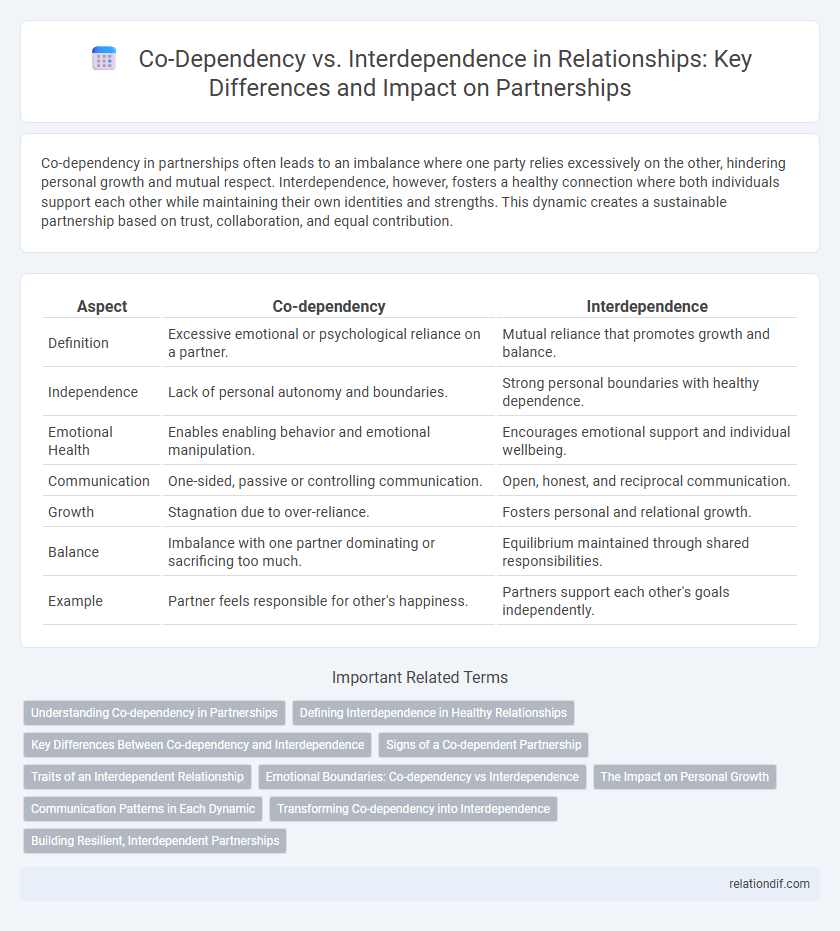Co-dependency in partnerships often leads to an imbalance where one party relies excessively on the other, hindering personal growth and mutual respect. Interdependence, however, fosters a healthy connection where both individuals support each other while maintaining their own identities and strengths. This dynamic creates a sustainable partnership based on trust, collaboration, and equal contribution.
Table of Comparison
| Aspect | Co-dependency | Interdependence |
|---|---|---|
| Definition | Excessive emotional or psychological reliance on a partner. | Mutual reliance that promotes growth and balance. |
| Independence | Lack of personal autonomy and boundaries. | Strong personal boundaries with healthy dependence. |
| Emotional Health | Enables enabling behavior and emotional manipulation. | Encourages emotional support and individual wellbeing. |
| Communication | One-sided, passive or controlling communication. | Open, honest, and reciprocal communication. |
| Growth | Stagnation due to over-reliance. | Fosters personal and relational growth. |
| Balance | Imbalance with one partner dominating or sacrificing too much. | Equilibrium maintained through shared responsibilities. |
| Example | Partner feels responsible for other's happiness. | Partners support each other's goals independently. |
Understanding Co-dependency in Partnerships
Co-dependency in partnerships often involves one partner enabling the other's unhealthy behaviors, creating an imbalanced dynamic where personal boundaries are blurred. This pattern fosters emotional reliance that undermines individual growth and mutual respect. Recognizing signs such as excessive people-pleasing and difficulty making decisions independently is essential for addressing co-dependency and promoting healthier relational interdependence.
Defining Interdependence in Healthy Relationships
Interdependence in healthy relationships involves mutual support where both partners maintain autonomy while relying on each other for emotional and practical needs. This balance fosters growth, trust, and resilience, avoiding the pitfalls of co-dependency that include excessive reliance and loss of individual identity. Healthy interdependence enhances communication and respect, creating a dynamic where both individuals contribute equally to the partnership's success.
Key Differences Between Co-dependency and Interdependence
Co-dependency involves excessive emotional or psychological reliance on a partner, often leading to unhealthy boundaries and loss of individual identity. Interdependence reflects a balanced relationship where both partners maintain autonomy while supporting each other's growth and well-being. Key differences include mutual respect, healthy communication, and the ability to function independently without fear of abandonment.
Signs of a Co-dependent Partnership
In a co-dependent partnership, one or both individuals excessively rely on each other for validation, leading to a loss of personal identity and boundaries. Signs include an overwhelming need to please the partner, difficulty making decisions independently, and sacrificing personal goals to maintain the relationship. This dynamic often results in emotional imbalance and an unhealthy attachment pattern that hinders mutual growth and self-sufficiency.
Traits of an Interdependent Relationship
Interdependent relationships thrive on mutual respect, open communication, and shared goals, fostering personal growth while maintaining individual autonomy. Partners demonstrate trust and support, balancing give and take without losing their sense of self. This dynamic encourages collaboration, emotional intimacy, and resilience, differentiating it sharply from co-dependency's imbalance and reliance.
Emotional Boundaries: Co-dependency vs Interdependence
Emotional boundaries in co-dependency are often blurred, leading to excessive reliance on a partner for self-worth and emotional stability, which undermines personal autonomy. Interdependence fosters healthy emotional boundaries by encouraging mutual support while maintaining individual identity and self-regulation. Establishing clear emotional boundaries in interdependent partnerships promotes resilience, balanced communication, and personal growth.
The Impact on Personal Growth
Co-dependency in partnerships often stifles personal growth by fostering excessive reliance on the other person, which can limit self-awareness and autonomy. Interdependence, however, promotes mutual support while encouraging individual development and emotional resilience. This balance enhances personal growth by allowing partners to thrive independently while benefiting from a healthy, supportive connection.
Communication Patterns in Each Dynamic
Co-dependency communication patterns often exhibit a lack of clear boundaries, with one partner excessively seeking approval and validation, leading to enabling behaviors and emotional strain. Interdependence fosters open, honest dialogue where both partners express needs and feelings while respecting each other's autonomy, promoting mutual support and growth. Effective communication in interdependent relationships enhances problem-solving and emotional resilience, contrasting with co-dependency's often conflict-avoidant and unclear exchanges.
Transforming Co-dependency into Interdependence
Transforming co-dependency into interdependence requires establishing healthy boundaries and fostering open communication to promote mutual respect and autonomy within the partnership. Emphasizing individual growth alongside shared goals helps partners balance reliance without sacrificing personal identity or control. Building trust and encouraging collaborative problem-solving create a resilient dynamic where both parties support each other while maintaining their independence.
Building Resilient, Interdependent Partnerships
Building resilient, interdependent partnerships requires fostering mutual trust, open communication, and shared goals that empower each partner while maintaining individual strengths. Co-dependency, characterized by excessive reliance and imbalance, undermines autonomy and long-term sustainability in relationships. Emphasizing interdependence cultivates collaboration, accountability, and adaptability, essential for navigating challenges and achieving collective success.
Co-dependency vs Interdependence Infographic

 relationdif.com
relationdif.com